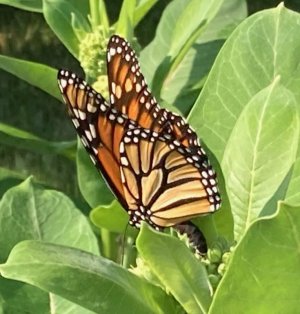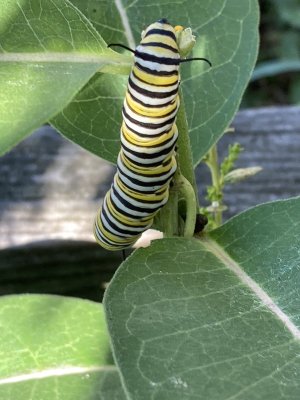I spy a flash of neon orange peaking between the faintest pink of the Common Milkweed (Asclepias syriaca) blossoms. I hold my breath and tiptoe forward to witness a Monarch butterfly (Danaus plexippus) checking out the real estate contained in my small mailbox garden. Imagine, this insect has just migrated to an unfamiliar region and is now searching for a home which must meet specific criteria. As a mom with a 2-year old in tow 20 years ago, I was looking beyond the basics: food, water and shelter. Just like the Monarch, finding a neighborhood to raise my young offspring was essential.
Butterflies seem to effortlessly fly, skip or float on what may be perceived as delicate wings. Classified as Lepidoptera (scale-winged insects) butterflies share many common traits yet each family and species have unique characteristics. All species have two pairs of wings, forewings and hindwings, as well as six jointed legs attached to the thorax. Each wing has a system of veins supported by “cross beams” for strength which is enclosed between two chitinous layers. The wings are covered with overlapping rows of tiny colorful textured scales, with light refracting abilities, also composed of chitin. Chitin is a strong, natural polymer that forms the exoskeletons of insects and crustaceans.
Consider a Monarch, emerging from a chrysalis in early September, a novice navigator instinctually migrating for two months. According to the Xerces Society, flying from Delaware to reach the mountains of central Mexico a Monarch may catch a wind current and fly up to 100 miles each day during a trip covering 2,500 to 3,000 miles. Their wings are so durable that at eight months old, after a chilly winter in snow covered pines, these same Monarchs will begin the journey north. Other regionally migratory butterflies include the Red Admiral and Painted Lady which will arrive in our gardens in late July and August from southern states. On strong wings, each butterfly may travel great distances over water, mountains, urban landscapes and unsuitable habitat to find the best location to reproduce.
With the power to move, how do the Monarchs, Black Swallowtails, Juniper Hairstreaks and Delaware Skippers know where to go? Hands down, butterflies win when it comes to seeing the widest range of colors of any animal, including humans. In addition to seeing the whole color spectrum, including ultraviolet, studies also suggest that butterflies are able to discern hues of blue and green, as well as patterns. A world hidden from our view enables butterflies to see road signs and runways directing them to the plants they need. Despite their incredible color vision what they view is blurred or fuzzy. The garden yellows of goldenrod (Solidago sp.), pinks of phlox ( Phlox sp.), and purples of beebalm (Monarda sp.) are ideal nectar sources when planted in groups of six or more. Many woodland butterflies feed on tree saps and overripe fruit. Mud puddles, shallow water containers, bird droppings, horse manure and animal scat are important to butterflies for moisture and minerals.
Now that basic needs have been met, the ideal habitat includes a place to raise young. The butterfly life cycle begins with an adult (imago) depositing an egg on a plant. In addition to their vision, chemoreceptors on each foot allow the female butterfly to locate and deposit her eggs on a pre-destined host plant. Each butterfly species has specific plant requirements for raising their young larva or caterpillar which is a voracious eater. The odds seem slim, but in a sea of green lawns and pavement, a female Monarch found my 4-foot by 6-foot garden filled with 30 milkweed plants (which is not common in our neighborhood). Each female has 100 to 300 eggs and seeks one plant for each egg. Last summer, I casually tallied 18 large white, black and yellow striped caterpillars ready to form a chrysalis.
Getting to know the host plants for favorite butterfly species will enhance your success in attracting them to your garden or seeing them in woodland and meadow habitats. A black and fluorescent - green striped caterpillar with neon yellow polka dots may enjoy your parsley before emerging as a Black Swallowtail Butterfly. A frosty moss-green Juniper Hairstreak with trailing black streamers will seek out an Eastern Red Cedar to feed its camouflaged caterpillars. The subtle tawny browns of a stout-bodied, big-eyed Delaware Skipper frequent annual Zinnias for nectar, but need grassy meadows for their host plants Big Bluestem (Andropogon gerardi) or Switchgrass (Panicum virgatum).

























































